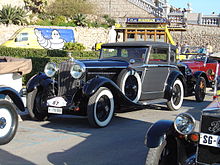Freestone & Webb
Freestone & Webb was a British coachwork company that manufactured special bodies for luxury automobiles from 1923 to 1958. Unlike many of its competitors, Freestone & Webb did not limit itself to cladding British chassis, but also supplied bodies for continental European brands. In this way, numerous bodies for chassis from Mercedes-Benz were made up into the late 1930s .
Company history
Freestone & Webb was founded in 1923 by VE Freestone and AJ Webb. Both had previously worked for the British subsidiary of the French car manufacturer Sizaire-Berwick , and Freestone had also worked for Crossley Motors . The company was based in the London borough of Willesden .
In the very first year of its existence, Freestone & Webb dressed a number of Bentley chassis. The superstructures impressed with their style and craftsmanship, so that Freestone & Webb soon earned a good reputation. Up until the late 1920s, a total of 230 bodies were produced for Bentley. After its bankruptcy in 1929, Freestone & Webb focused on Rolls-Royce chassis. Some bodies followed the Weymann process, i.e. consisted of a wooden structure with an artificial leather cover. According to observers, Freestone & Webb's bodies were among the most attractive Weymann bodies.
In 1925 Freestone & Webb built a Packard chassis for the first time . The Six Series 333 had a sedan body with an innovative roof, the front part of which could be lifted by means of double straps attached to the side and pushed over the rear part. More sedans and convertibles for Packard followed by 1938. Also known are some very elegant Delage- based bodies , including a Type DMS Torpedo (1928) and two D8S Coach (two-door inner handlebars) from 1932 and 1933
In the 1930s, the company went through a number of economic crises. It has been restructured several times. VE Freestone left the company in the mid-1930s. During this time it produced about 15 bodies each for chassis from Alfa Romeo , Alvis , Daimler , Lagonda , Mercedes-Benz, Rolls-Royce and Talbot . At least two bodies were manufactured for Hispano-Suiza , namely an H.6B Open Drive Sedan in 1928 and a K.6 Berline in 1937. Some bodies were standardized; In addition, there was still the option of completely individual bodies that were tailored to the respective customer requirements. In 1935, a body in the so-called razor-edge look was created for a Bentley chassis for the first time , which would become the trademark of Freestone & Webb in the following years. The company's superstructures continued to be valued. Freestone & Webb won gold medals nine times in a row in the "Best Private Bodybuilder" category at the annual London Motor Show . The last superstructure for Packard, a chauffeur limousine on the Super Eight chassis, was also held in the Razor Edge style and looked very British in its design.
During World War II , Freestone & Webb manufactured accessories for the Supermarine Spitfire fighter aircraft for the War Department .
After the war, Freestone & Webb resumed the production of automobile bodies. However, the framework conditions soon changed: From 1946, Rolls-Royce offered standardized factory bodies for the first time with the Silver Wraith and the Bentley Mark VI . The possibility of individual bodies still existed, but in view of the emergence of factory bodies, the demand for special bodies declined significantly at the beginning of the 1950s. Freestone & Webb ran into financial difficulties and, two years after AJ Webb's death, the company was sold in May 1957 to the Swain Group, which was active in the automobile trade. In 1958, Freestone & Webb stopped producing vehicle bodies. The company was connected to the Rolls-Royce dealer HR Owen, which was part of the same group, and became a pure car dealer. In 1963, the body shop company Harold Radford took over the naming rights to Freestone & Webb.
literature
- Nick Walker: A – Z of British Coachbuilders 1919–1960. Herridge & Sons Ltd., Shebbear 2007, ISBN 978-0-9549981-6-5 .
- GN Georgano (Ed.): Complete Encyclopedia of Motorcars, 1885 to the Present. 2nd edition (hardcover). Dutton Press, New York 1973, ISBN 0-525-08351-0 .
- Hugo Pfau: The Coachbuilt Packard. Dalton-Watson Ltd./ Motorbooks International, London / Minneapolis 1973, ISBN 0-901564-10-9 .
Web links
- Company history on the website www.coachbuild.com
- traumautoarchiv.de: Hispano-Suiza H6B Open Drive Limousine by Freestone & Webb (1928) (accessed on April 13, 2013)
- artfact.com: Delage Type DMS Torpedo by Freestone & Webb (1928) (English) (accessed April 13, 2013)
- imcdb.org: Delage D8 S FHC Freestone & Webb (1932) in the film 23 Paces to Baker Street (1956) (English) (accessed April 13, 2013)
- conceptcarz.com: Delage D8S Coach by Freestone & Webb (1932 ) (accessed April 13, 2013). Note: probably built in 1933, s. u.
- mercurypress.photoshelter.com: Delage D8S Coach by Freestone & Webb (1933 ) (accessed April 13, 2013)
- rmauctions.com: Delage D8S Coach by Freestone & Webb (1933 ) (accessed April 13, 2013)
Individual evidence
- ^ Walker: AZ of British Coach Builders. S: 112.
- ↑ a b c Pfau: The Coachbuilt Packard. 1973, pp. 208/209.
- ^ Georgano: Complete Encyclopedia of Motorcars, 1885 to the Present. 1973, p. 530.
- ↑ artfact.com: Delage Type DMS Torpedo by Freestone & Webb (1928)
- ↑ imcdb.org: Delage D8 S FHC Freestone & Webb (1932) in the film 23 Paces to Baker Street (1956)
- ↑ conceptcarz.com: Delage D8S Coach by Freestone & Webb (1932)
- ↑ mercurypress.photoshelter.com: Delage D8S Coach by Freestone & Webb (1933)
- ↑ rmauctions.com: Delage D8S Coach by Freestone & Webb (1933)
- ↑ prewarcars.com
- ↑ Company history on the website www.coachbuild.com (accessed on February 19, 2013).


